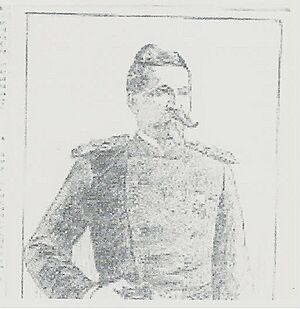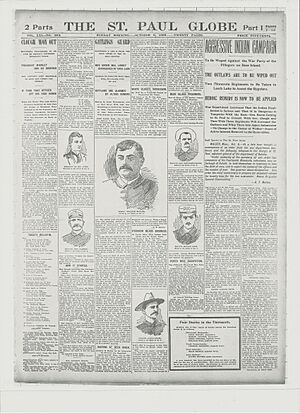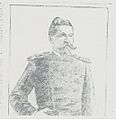Battle of Sugar Point facts for kids
Quick facts for kids Battle of Sugar Point |
|||||||
|---|---|---|---|---|---|---|---|
| Part of the American Indian Wars | |||||||
 Ojibways in a canoe on Leech Lake, 1896. |
|||||||
|
|||||||
| Belligerents | |||||||
| Chippewa | |||||||
| Commanders and leaders | |||||||
| Bugonaygeshig | |||||||
| Strength | |||||||
| 900 warriors | 500 | ||||||
| Casualties and losses | |||||||
| none killed | 7 killed {including 1 Indian Policeman shot by mistake} 19 wounded |
||||||
The Battle of Sugar Point, also called the Battle of Leech Lake, happened on October 5, 1898. It was a fight between soldiers from the U.S. Army and members of the Pillager Band of Chippewa Indians. The soldiers tried to arrest a Pillager Ojibwe leader named Bugonaygeshig. This conflict started because of disagreements with government officials on the Leech Lake Reservation in Cass County, Minnesota.
This event is often called "the last Indian Uprising in the United States." It was also the first battle in the Old Northwest area since the Black Hawk War in 1832. A special award, the Medal of Honor, was given to Private Oscar Burkard for his bravery in this battle. It was the last Medal of Honor given during the Indian Wars.
Contents
Why the Battle Happened
Problems with the Government
A big problem for the Pillager people was how they were treated by government officials. Tribal members were often arrested for small reasons. They were taken to federal courts far from their homes for trials. Even people who just saw something happen were forced to travel far away to be witnesses.
Disputes Over Timber
Another issue was about logging companies cutting down trees. These companies paid for the timber they took. But the value of the trees was often guessed to be too low. Payments were also often late. Some loggers even damaged healthy trees on purpose. They would then claim the trees were already dead to cut them down for less money.
Bugonaygeshig's Escape
In early 1898, a Pillager named Bugonaygeshig spoke out against these logging practices. On September 15, he and Sha-Boon-Day-Shkong went to a nearby village. There, a U.S. Deputy Marshal and an Indian Agent tried to arrest them. They were wanted as witnesses in a dispute over goods. Bugonaygeshig had already been a witness in a similar case five months earlier.
As they were being led away, other Pillagers helped Bugonaygeshig and Sha-Boon-Day-Shkong escape. They returned to their homes on Sugar Point.
Soldiers Arrive
After Bugonaygeshig escaped, the Indian Agent asked the military for help. A small group of 20 soldiers was sent from Fort Snelling. Their leader, Lieutenant Chauncey B. Humphreys, learned that Bugonaygeshig would not surrender. So, he asked for more soldiers to be sent.
A larger group of 77 soldiers soon arrived. This force included Major Melville C. Wilkinson and General John M. Bacon. U.S. Marshals, Indian Police, and reporters also joined them.
The soldiers traveled on two steamships, the Flora and the Chief of Duluth. They sailed across Leech Lake from Walker, Minnesota. Their destination was Sugar Point, a small piece of land sticking out into the lake.
The Battle Begins
Searching for Bugonaygeshig
When the soldiers landed at Sugar Point, they quickly arrested two Pillagers. These men had helped Bugonaygeshig escape earlier. But Bugonaygeshig himself was not there. He had left before the soldiers arrived. The soldiers set up camp and started searching the nearby woods and villages. They looked for any Pillagers who had arrest warrants. They found very few men in the area.
Who Fired First?
It's not clear who fired the first shot. General Bacon said a soldier's rifle went off by accident. He claimed this made the Pillagers think they were being attacked. But the Pillagers said the battle started when soldiers shot at an Indian canoe with women in it. This happened as the steamship got close to Sugar Point.
Around 11:30 AM, the Pillagers started shooting from the woods. Many soldiers were young and new to fighting. They dropped to the ground. Their officers helped them form a line around Bugonaygeshig's cabin.
Heavy Fighting
In the first 30 minutes, several soldiers were killed or hurt. Major Wilkinson was shot in the leg. He and other wounded soldiers moved behind the cabin for safety.
After his leg was bandaged, Major Wilkinson went back out. He encouraged his young soldiers. But he was shot again and carried back into the cabin. He died about an hour later. Another soldier, Sergeant William Butler, was also killed. He was trying to tell General Bacon about Major Wilkinson's injury. After this, the Pillagers fired less often. But they still took occasional shots throughout the day.
That evening, an Indian policeman was accidentally killed by a soldier. The soldier thought he was one of the Pillagers. The next morning, another soldier was killed while looking for food. He was the last person to die in the battle.
End of the Battle
The Pillagers left early the next day. The soldiers then headed back to Walker. Six soldiers, including Major Wilkinson, were killed. Ten others were wounded. No civilians were killed, but five were wounded, including a second Indian policeman. Bugonaygeshig was never captured after his escape.
What Happened Next
Fears and Investigations
News of the battle caused panic. People worried about a larger uprising and attacks on nearby towns. More soldiers were sent from Fort Snelling. The Minnesota National Guard also got ready. Local settlers formed groups to protect themselves.
However, the Ojibwe people quickly left their villages. They went to remote parts of the reservation. They were afraid the army or settlers would get revenge. Soon, newspapers reported the true story of the battle. Public fears of a new uprising began to calm down.
The day after the battle, a newspaper published a letter from the Pillager chiefs. They explained their problems. They said their people were suffering. They asked for an honest group to investigate the issues. They worried about losing their pine lands, which were their future support. They said the value of the timber was being underestimated. They also mentioned that fires were being set to make healthy trees seem damaged.
Peace Talks
A few days later, a U.S. government official named William A. Jones met with Pillager leaders. This meeting happened at the Leech Lake Reservation from October 10-15. After the meeting, Commissioner Jones criticized local officials. He said they often arrested Indians for small or no reasons. He noted they were taken far away for trials and then left without money to get home.
Jones later wrote a report to the Secretary of the Interior. He stated that the Indians fought because of unfair treatment. He said they would live peacefully if white people treated them fairly. He believed the battle taught everyone an important lesson.
The last person who lived through the battle was Emma Bear. She died in Cass Lake on July 13, 2001, at 103 years old. She was only 8 months old when the battle happened. Her father, Bear (Makwa), and George White, tried to make peace with the soldiers. But they were arrested before the battle began.
Images for kids






